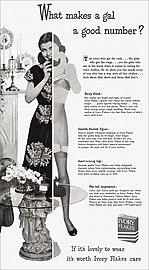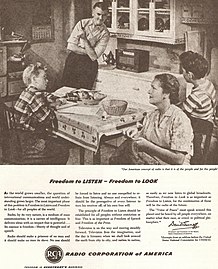Summary
McLuhan is concerned by the size and the intentions of the North American culture industry. "Ours is the first age in which many thousands of the best-trained individual minds have made it a full-time business to get inside the collective public mind," McLuhan writes in his preface to the book. He believes everyone is kept in a "helpless state engendered by prolonged mental rutting is the effect of many ads and much entertainment alike." [3] McLuhan hopes Bride can reverse this process.
By using artifacts of popular culture as a means to enlighten the public, McLuhan hopes the public can consciously observe the effects of popular culture on them. [3]
McLuhan compares his method to the sailor in Edgar Allan Poe's short-story "A Descent into the Maelstrom." The sailor, McLuhan writes, saves himself by studying the whirlpool and by co-operating with it. [3] Likewise, the book is not interested in attacking the strong currents of advertising, radio, and the press.
The book argues anger and outrage are not the proper responses to the culture industry. "The time for anger...is in the early stages of a new process," McLuhan says, "the present stage is extremely advanced." [3] Amusement is the proper strategy. This is why McLuhan uses punning questions that border on silly or absurd after each visual example.
On the technique of amusement McLuhan quotes Poe's sailor, when he's locked into the whirlpool's walls looking at floating objects:
- "I must have been delirious, for I even sought amusement in speculating upon the relative velocities of their several descents towards the foam below." [italics original] [3]
This amusement, McLuhan argues, born "of his rational detachment as a spectator of his own situation," [3] saved the sailor's life. By adopting the position of Poe's sailor, readers of Bride can escape from the whirlpool of popular culture.
Origins
Marshall McLuhan's interest in the critical study of popular culture was influenced by the 1933 book Culture and Environment by F. R. Leavis (with Denys Thompson) and Wyndham Lewis' 1932 book Doom of Youth, which uses similar exhibits. [4]
During the 1940s, McLuhan regularly held lectures with slides of advertisements analysing them. He first referred to the present era as the Age of the Mechanical Bride in 1945, during a series of lectures in Windsor, Ontario. [4] McLuhan had planned on publishing these lectures and slides since before 1945. [5]
During the thirties and forties, many "exposé" books critiquing the advertising industry were published [6] but McLuhan's book was different. While critical, the tone of the essays was admiring at times, impressed with the skills of advertisers. [6] Despite the influence, McLuhan was far more playful in The Mechanical Bride than Leavis was in Culture and Environment. [6]
In June 1948, McLuhan received an advance of $250 for the publication of The Folklore of Industrial Man from Vanguard Press. [7] The tentative title would later become the subtitle.
The title The Mechanical Bride comes from a piece by the French avant-garde artist, Marcel Duchamp, titled The Bride Stripped Bare By Her Bachelors, Even . [8]
The book underwent several title changes over four manuscripts before McLuhan settled on Bride. The first manuscript was titled Guide to Chaos. The following three manuscripts were titled Typhon in America, after the Ancient Greek mythological monster. The eventual title of the book reflects McLuhan's concern about the merging of sex and technology in advertising. [9]
McLuhan was frustrated by the editorial efforts of Vanguard Press. He resisted requests to cut entries, to expand on subjects, give examples, underline a point, or generally make the book easier for readers to understand. [10] He would verbally abuse Vanguard Press staff, accusing editors of wearing him down with editorial requests. [11] He began to suffer from severe headaches during this period, possibly products of the stress, anger, and frustration of his dealings with Vanguard. [10]
The Mechanical Bride was published in the fall of 1951. [10] The book was well-reviewed but it was not a financial success, only selling a few hundred copies. [12] Biographer Philip Marchand reports that after the publication, McLuhan complained of a vague "homosexual influence in the publishing world, that was horrified by the masculine vigor of his prose and trying to castrate his text." [10] McLuhan bought one thousand copies and sold them individually to bookshops and students. [12] By the 1970s, hardcover first editions of The Mechanical Bride became sought after items in the rare book business. [12]

Herbert Marshall McLuhan was a Canadian philosopher whose work is among the cornerstones of the study of media theory. He studied at the University of Manitoba and the University of Cambridge. He began his teaching career as a professor of English at several universities in the United States and Canada before moving to the University of Toronto in 1946, where he remained for the rest of his life.

Harold Adams Innis was a Canadian professor of political economy at the University of Toronto and the author of seminal works on media, communication theory, and Canadian economic history. He helped develop the staples thesis, which holds that Canada's culture, political history, and economy have been decisively influenced by the exploitation and export of a series of "staples" such as fur, fish, lumber, wheat, mined metals, and coal. The staple thesis dominated economic history in Canada from the 1930s to 1960s, and continues to be a fundamental part of the Canadian political economic tradition.
Media ecology theory is the study of media, technology, and communication and how they affect human environments. The theoretical concepts were proposed by Marshall McLuhan in 1964, while the term media ecology was first formally introduced by Neil Postman in 1968.

Eric McLuhan was a communications theorist and media ecologist, son of Marshall McLuhan.

Understanding Media: The Extensions of Man is a 1964 book by Marshall McLuhan, in which the author proposes that the media, not the content that they carry, should be the focus of study. He suggests that the medium affects the society in which it plays a role mainly by the characteristics of the medium rather than the content. The book is considered a pioneering study in media theory.
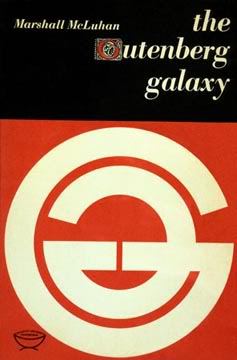
The Gutenberg Galaxy: The Making of Typographic Man is a 1962 book by Marshall McLuhan, in which the author analyzes the effects of mass media, especially the printing press, on European culture and human consciousness. It popularized the term global village, which refers to the idea that mass communication allows a village-like mindset to apply to the entire world; and Gutenberg Galaxy, which we may regard today to refer to the accumulated body of recorded works of human art and knowledge, especially books.
David Carson is an American graphic designer and design director.

The Medium Is the Massage: An Inventory of Effects is a book co-created by media analyst Marshall McLuhan and graphic designer Quentin Fiore, with coordination by Jerome Agel. It was published by Bantam Books in 1967 and became a bestseller with a cult following. The U.K. edition was published by Allen Lane Penguin Books using cover art by Newsweek photographer Tony Rollo.
Technoculture is a neologism that is not in standard dictionaries but that has some popularity in academia, popularized by editors Constance Penley and Andrew Ross in a book of essays bearing that title. It refers to the interactions between, and politics of, technology and culture.
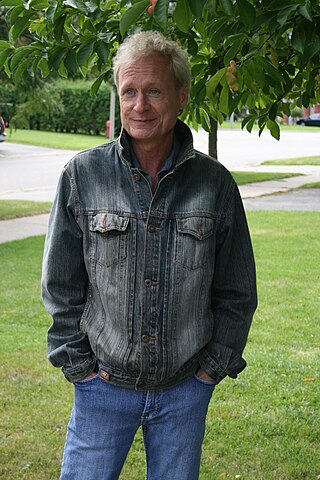
Bruce William Powe, commonly known as B. W. Powe, is a Canadian poet, novelist, essayist, philosopher, and teacher.

Marshall McLuhan's tetrad of media effects uses a tetrad to examine the effects on society of any technology/medium by dividing its effects into four categories and displaying them simultaneously. The tetrad first appeared in print in McLuhan's posthumously-published works Laws of Media (1988) and The Global Village (1989).
Global village describes the phenomenon of the entire world becoming more interconnected as the result of the propagation of media technologies throughout the world. The term was coined by Canadian media theorist Marshall McLuhan in his books The Gutenberg Galaxy: The Making of Typographic Man (1962) and Understanding Media (1964). Literary scholar Sue-Im Lee describes how the term global village has come to designate “the dominant term for expressing a global coexistence altered by transnational commerce, migration, and culture”. Economic journalist Thomas Friedman's definition of the global village as a world “tied together into a single globalized marketplace and village” is another contemporary understanding of the term.
This is a bibliography of Marshall McLuhan's works.
Harold Adams Innis was a professor of political economy at the University of Toronto and the author of seminal works on Canadian economic history and on media and communication theory. He helped develop the staples thesis, which holds that Canada's culture, political history and economy have been decisively influenced by the exploitation and export of a series of staples such as fur, fish, wood, wheat, mined metals and fossil fuels. Innis's communications writings explore the role of media in shaping the culture and development of civilizations. He argued, for example, that a balance between oral and written forms of communication contributed to the flourishing of Greek civilization in the 5th century BC. But he warned that Western civilization is now imperiled by powerful, advertising-driven media obsessed by "present-mindedness" and the "continuous, systematic, ruthless destruction of elements of permanence essential to cultural activity."
The Toronto School is a school of thought in communication theory and literary criticism, the principles of which were developed chiefly by scholars at the University of Toronto. It is characterized by exploration of Ancient Greek literature and the theoretical view that communication systems create psychological and social states. The school originated from the works of Eric A. Havelock and Harold Innis in the 1930s, and grew to prominence with the contributions of Edmund Snow Carpenter, Northrop Frye and Marshall McLuhan.
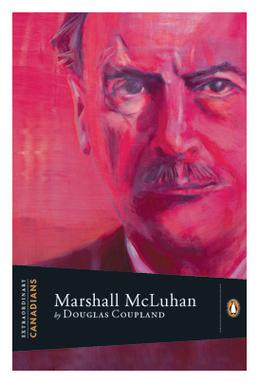
Marshall McLuhan is a biography written by Canadian author Douglas Coupland as a part of Penguin Canada's Extraordinary Canadians series. It was published in March 2011 in the US by Atlas & Company under the title, "Marshall McLuhan: You Know Nothing of my Work!". The American edition omits the preface describing the Extraordinary Canadians series by John Ralston Saul.
Howard Luck Gossage (1917–1969), frequently referred to as "The Socrates of San Francisco," was an advertising innovator and iconoclast during the "Mad Men" era. He is known for having said that, "The object of your advertising should not be to communicate with your consumers or your prospects at all but to terrorize your competition's copywriters."
New media studies is an academic discipline that explores the intersections of computing, science, the humanities, and the visual and performing arts. Janet Murray, a prominent researcher in the discipline, describes this intersection as "a single new medium of representation, the digital medium, formed by the braided interplay of technical invention and cultural expression at the end of the 20th century". The main factor in defining new media is the role the Internet plays; new media is effortlessly spread instantly. The category of new media is occupied by devices connected to the Internet, an example being a smartphone or tablet. Television and cinemas are commonly thought of as new media but are ruled out since the invention was before the time of the internet.

The Faculty of English is a constituent part of the University of Cambridge. It was founded in 1914 as a Tripos within the Faculty of Medieval and Modern Languages. It could be studied only as a 'Part I' of a degree course, alongside a 'Part II' either in medieval languages or from another Tripos. In 1926, the course became a distinct Faculty.




